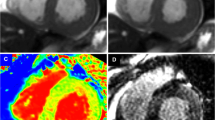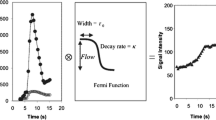Abstract
Myocardial perfusion MRI is acquired with a T1-weighted dynamic MRI sequence. Fully quantitative analysis of myocardial perfusion MRI allows the absolute quantification of myocardial blood flow (MBF) through the use of complex mathematical modeling. There are essentially two main methods for quantification of absolute MBF: the linear time-invariant model and the compartment model. Maximized contrast-to-noise ratio and the reasonable linearity of signal intensity in blood and myocardium are crucial for the accuracy of absolute MBF quantification by MRI. Quantitative assessment of MBF permits an accurate and objective assessment of myocardial perfusion and perfusion reserve in patients. This is of particular significance in patients with coronary artery disease but will also provide a means for investigating globally altered MBF in patients with microvascular disease of the heart. Furthermore, quantification of MBF with magnetic resonance can provides us with an important tool for monitoring disease progression and measuring the response to therapeutic interventions.





Similar content being viewed by others
References
Papers of particular interest, published recently, have been highlighted as: • Of Importance •• Of Major Importance
Nagel E, Klein C, Paetsch I, et al.: Magnetic resonance perfusion measurements for the noninvasive detection of coronary artery disease. Circulation 2003, 108:432–437.
Ishida N, Sakuma H, Motoyasu M, et al.: Noninfarcted myocardium: correlation between dynamic first-pass contrast-enhanced myocardial MR imaging and quantitative coronary angiography. Radiology 2003, 229:209–216.
Ishida M, Sakuma H, Kato N, et al.: Contrast-enhanced MR imaging for evaluation of coronary artery disease before elective repair of aortic aneurysm. Radiology 2005, 237:458–464.
Al-Saadi N, Nagel E, Gross M, et al.: Noninvasive detection of myocardial ischemia from perfusion reserve based on cardiovascular magnetic resonance. Circulation 2000,101:1379–1383.
Al-Saadi N, Nagel E, Gross M, et al.: Improvement of myocardial perfusion reserve early after coronary intervention: assessment with cardiac magnetic resonance imaging. J Am Coll Cardiol 2000, 36:1557–1564.
•• Jerosch-Herold M, Wilke N, Stillman AE: Magnetic resonance quantification of the myocardial perfusion reserve with a Fermi function model for constrained deconvolution. Med Phys 1998, 25:73–84. This work demonstrated the theory and feasibility of a Fermi function deconvolution method for the quantification of myocardial perfusion with myocardial perfusion MRI.
•• Jerosch-Herold M, Swingen C, Seethamraju RT: Myocardial blood flow quantification with MRI by model-independent deconvolution. Med Phys 2002, 29:886–897. This work demonstrated the theory and feasibility of a model-independent analysis for the quantification of myocardial perfusion with myocardial perfusion MRI.
Pack NA, DiBella EV, Rust TC, et al.: Estimating myocardial perfusion from dynamic contrast-enhanced CMR with a model-independent deconvolution method. J Cardiovasc Magn Reson 2008, 10:52.
•• Parkka JP, Niemi P, Saraste A, et al.: Comparison of MRI and positron emission tomography for measuring myocardial perfusion reserve in healthy humans. Magn Reson Med 2006, 55:772–779. This article demonstrated that MRI supplemented with tracer kinetic modeling based on compartmental analysis of the gadolinium contrast agent uptake can be used to quantify myocardial perfusion.
•• Fritz-Hansen T, Hove JD, Kofoed KF, et al.: Quantification of MRI measured myocardial perfusion reserve in healthy humans: a comparison with positron emission tomography. J Magn Reson Imaging 2008, 27:818–824. This work provided validation of the perfusion marker K 1 derived by the MRI method as a quantitative marker for myocardial perfusion in healthy humans.
•• Ichihara T, Ishida M, Kitagawa K, et al.: Quantitative analysis of first-pass contrast-enhanced myocardial perfusion MRI using a Patlak plot method and blood saturation correction. Magn Reson Med 2009, 62:373–383. This article demonstrated a method for quantifying myocardial K 1 and MBF with minimal operator interaction by using a Patlak plot method and for comparing the MBF obtained by perfusion MRI with that from coronary sinus blood flow. It also described a method that can correct for the nonlinearity of the blood time–signal intensity curve on perfusion magnetic resonance images.
Muehling OM, Huber A, Cyran C, et al.: The delay of contrast arrival in magnetic resonance first-pass perfusion imaging: a novel non-invasive parameter detecting collateral-dependent myocardium. Heart 2007, 93:842–847.
Wilke N, Jerosch-Herold M, Wang Y, et al.: Myocardial perfusion reserve: assessment with multisection, quantitative, first-pass MR imaging. Radiology 1997, 204:373–384.
Futamatsu H, Wilke N, Klassen C, et al.: Evaluation of cardiac magnetic resonance imaging parameters to detect anatomically and hemodynamically significant coronary artery disease. Am Heart J 2007, 154:298–305.
Hsu LY, Rhoads KL, Holly JE, et al.: Quantitative myocardial perfusion analysis with a dual-bolus contrast-enhanced first-pass MRI technique in humans. J Magn Reson Imaging 2006, 23:315–322.
Christian TF, Rettmann DW, Aletras AH, et al.: Absolute myocardial perfusion in canines measured by using dual-bolus first-pass MR imaging. Radiology 2004, 232:677–684.
• Christian TF, Aletras AH, Arai AE: Estimation of absolute myocardial blood flow during first-pass MR perfusion imaging using a dual-bolus injection technique: comparison to single-bolus injection method. J Magn Reson Imaging 2008, 27:1271–1277. This article demonstrated the importance of saturation correction of the nonlinear relationship between LV blood gadolinium concentration and signal intensity, and the usefulness of the dual-bolus technique for absolute MBF quantification by comparing the dual-bolus method with the single-bolus method.
• Utz W, Greiser A, Niendorf T, et al.: Single- or dual-bolus approach for the assessment of myocardial perfusion reserve in quantitative MR perfusion imaging. Magn Reson Med 2008, 59:1373–1377. This article demonstrated the usefulness of the dual-bolus technique to obtain accurate MPR values by comparing the dual-bolus method with the single-bolus method.
Kostler H, Ritter C, Lipp M, et al.: Prebolus quantitative MR heart perfusion imaging. Magn Reson Med 2004, 52:296–299.
Ishida M, Sakuma H, Murashima S, et al.: Absolute blood contrast concentration and blood signal saturation on myocardial perfusion MRI: estimation from CT data. J Magn Reson Imaging 2009, 29:205–210.
Ritter C, Brackertz A, Sandstede J, et al.: Absolute quantification of myocardial perfusion under adenosine stress. Magn Reson Med 2006, 56:844–849.
Gatehouse PD, Elkington AG, Ablitt NA, et al.: Accurate assessment of the arterial input function during high-dose myocardial perfusion cardiovascular magnetic resonance. J Magn Reson Imaging 2004, 20:39–45.
Vallee JP, Lazeyras F, Kasuboski L, et al.: Quantification of myocardial perfusion with FAST sequence and Gd bolus in patients with normal cardiac function. J Magn Reson Imaging 1999, 9:197–203.
Cernicanu A, Axel L: Theory-based signal calibration with single-point T1 measurements for first-pass quantitative perfusion MRI studies. Acad Radiol 2006, 13:686–693.
• Utz W, Niendorf T, Wassmuth R, et al.: Contrast-dose relation in first-pass myocardial MR perfusion imaging. J Magn Reson Imaging 2007, 25:1131–1135. This article demonstrated the importance of the correction of the signal saturation in both the LV blood pool and the myocardium for the accurate quantification of MBF with myocardial perfusion MRI.
Hsu LY, Kellman P, Arai AE: Nonlinear myocardial signal intensity correction improves quantification of contrast-enhanced first-pass MR perfusion in humans. J Magn Reson Imaging 2008, 27:793–801.
Zierler KL: Equations for measuring blood flow by external monitoring of radioisotopes. Circ Res 1965, 16:309–321.
Jerosch-Herold M, Seethamraju RT, Swingen CM, et al.: Analysis of myocardial perfusion MRI. J Magn Reson Imaging 2004, 19:758–770.
Neyran B, Janier MF, Casali C, et al.: Mapping myocardial perfusion with an intravascular MR contrast agent: robustness of deconvolution methods at various blood flows. Magn Reson Med 2002, 48:166–179.
Jerosch-Herold M, Hu X, Murthy NS, Seethamraju RT: Time delay for arrival of MR contrast agent in collateral-dependent myocardium. IEEE Trans Med Imaging 2004, 23:881–890.
Heymann MA, Payne BD, Hoffman JI, Rudolph AM: Blood flow measurements with radionuclide-labeled particles. Prog Cardiovasc Dis 1977, 20:55–79.
Schwitter J, Nanz D, Kneifel S, et al.: Assessment of myocardial perfusion in coronary artery disease by magnetic resonance: a comparison with positron emission tomography and coronary angiography. Circulation 2001, 103:2230–2235.
Tong CY, Prato FS, Wisenberg G, et al.: Techniques for the measurement of the local myocardial extraction efficiency for inert diffusible contrast agents such as gadopentate dimeglumine. Magn Reson Med 1993, 30:332–336.
Tong CY, Prato FS, Wisenberg G, et al.: Measurement of the extraction efficiency and distribution volume for Gd-DTPA in normal and diseased canine myocardium. Magn Reson Med 1993, 30:337–346.
Larsson HB, Stubgaard M, Sondergaard L, Henriksen O: In vivo quantification of the unidirectional influx constant for Gd-DTPA diffusion across the myocardial capillaries with MR imaging. J Magn Reson Imaging 1994, 4:433–440.
Larsson HB, Fritz-Hansen T, Rostrup E, et al.: Myocardial perfusion modeling using MRI. Magn Reson Med 1996, 35:716–726.
Diesbourg LD, Prato FS, Wisenberg G, et al.: Quantification of myocardial blood flow and extracellular volumes using a bolus injection of Gd-DTPA: kinetic modeling in canine ischemic disease. Magn Reson Med 1992, 23:239–253.
Vallee JP, Sostman HD, MacFall JR, et al.: Quantification of myocardial perfusion by MRI after coronary occlusion. Magn Reson Med 1998, 40:287–297.
Kety SS: The theory and applications of the exchange of inert gas at the lungs and tissues. Pharmacol Rev 1951, 3:1–41.
Costa MA, Shoemaker S, Futamatsu H, et al.: Quantitative magnetic resonance perfusion imaging detects anatomic and physiologic coronary artery disease as measured by coronary angiography and fractional flow reserve. J Am Coll Cardiol 2007, 50:514–522.
Kurita T, Sakuma H, Onishi K, et al.: Regional myocardial perfusion reserve determined using myocardial perfusion magnetic resonance imaging showed a direct correlation with coronary flow velocity reserve by Doppler flow wire. Eur Heart J 2009, 30:444–452.
Panting JR, Gatehouse PD, Yang GZ, et al.: Abnormal subendocardial perfusion in cardiac syndrome X detected by cardiovascular magnetic resonance imaging. N Engl J Med 2002, 346:1948–1953.
Cannon RO 3rd: Microvascular angina and the continuing dilemma of chest pain with normal coronary angiograms. J Am Coll Cardiol 2009, 54:877–885.
Rivard AL, Swingen CM, Blake D, et al.: A comparison of myocardial perfusion and rejection in cardiac transplant patients. Int J Cardiovasc Imaging 2007, 23:575–582.
Selvanayagam JB, Jerosch-Herold M, Porto I, et al.: Resting myocardial blood flow is impaired in hibernating myocardium: a magnetic resonance study of quantitative perfusion assessment. Circulation 2005,112:3289–3296.
Selvanayagam JB, Cheng AS, Jerosch-Herold M, et al.: Effect of distal embolization on myocardial perfusion reserve after percutaneous coronary intervention: a quantitative magnetic resonance perfusion study. Circulation 2007, 116:1458–1464.
Gebker R, Jahnke C, Paetsch I, et al.: Diagnostic performance of myocardial perfusion MR at 3 T in patients with coronary artery disease. Radiology 2008, 247:57–63.
Plein S, Schwitter J, Suerder D, et al.: k-Space and time sensitivity encoding-accelerated myocardial perfusion MR imaging at 3.0 T: comparison with 1.5 T. Radiology 2008, 249:493–500.
Christian TF, Bell SP, Whitesell L, Jerosch-Herold M: Accuracy of cardiac magnetic resonance of absolute myocardial blood flow with a high-field system: comparison with conventional field strength. JACC Cardiovasc Imaging 2009, 2:1103–1110.
Weng AM, Ritter CO, Lotz J, et al.: Automatic postprocessing for the assessment of quantitative human myocardial perfusion using MRI. Eur Radiol 2009 Dec 17 (Epub ahead of print).
Disclosure
No potential conflicts of interest relevant to this article were reported.
Author information
Authors and Affiliations
Corresponding author
Rights and permissions
About this article
Cite this article
Ishida, M., Morton, G., Schuster, A. et al. Quantitative Assessment of Myocardial Perfusion MRI. curr cardiovasc imaging rep 3, 65–73 (2010). https://doi.org/10.1007/s12410-010-9013-0
Published:
Issue Date:
DOI: https://doi.org/10.1007/s12410-010-9013-0




